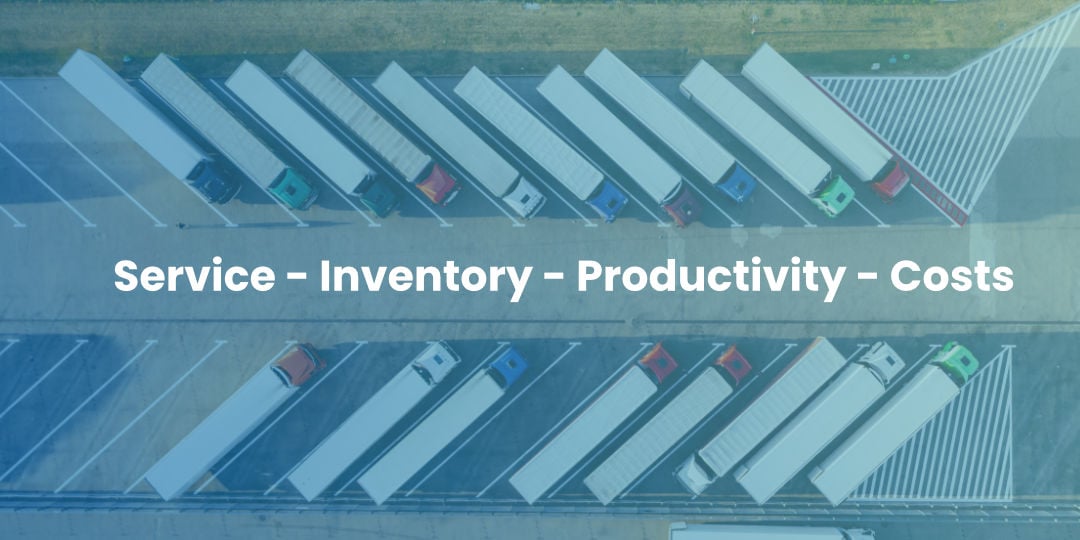Logistics KPI Metrics You Can Affect With On-Demand Labor
Note: This article is tailored for logistics & distribution operations - to read the manufacturing version, click here
Maybe you’ve heard of on-demand labor and you thought it sounds like a great solution for finding workers when you need them. But what goals can you achieve in a logistics operation with on-demand labor?
At Veryable, I see logistics companies using on-demand labor all the time to improve their operations in a variety of innovative ways. These businesses are improving against their key performance indicators, and I’ve heard many different metrics that businesses track. However, I’ve had several conversations with our team to find commonalities that we feel are worth sharing.
In this article, you’ll learn common logistics metrics across five key performance categories and how you can improve them with on-demand labor. You’ll know how you can affect service, inventory, productivity, and cost metrics in your logistics operation by bringing in workers on demand.
Types of Metrics you can Impact Through On-Demand Labor
Service Metrics
Service metrics will keep you informed on how well you’re meeting customer expectations and distinguishing yourself from other companies. When it comes to delighting the customer, service metrics can make or break your efforts. The table below shows some common service metrics to track.

Fill Rate
Fill rate is defined as the percentage of customer demand that is met by immediate stock availability without backorders, stockouts, or lost sales.
This is a good measure of how well you’re keeping your promises to customers. It’s a basic metric, and you should never let this one slip or you’re going to be in hot water. In fact, many service level agreements outline minimum expected levels. Failure to meet them can be just cause for termination of contracts.
How on-demand labor can impact fill rate
On-demand labor can help you avoid backorders, stockouts, and losing your sales by getting workers in the door fast to help you stay on track with shipping your orders.
On-time Delivery
On-time delivery is defined as the percentage of orders that arrive at their final destination at the agreed-upon time.
The truest measure of on-time delivery is whether or not you were able to meet the customer’s requested time, rather than the quoted time. Sure, they might be understanding of your limitations and be okay with you just meeting what you agree on. But if you can strive that little bit extra to get them the product faster, you can be more competitive in the marketplace.
How on-demand labor can impact on-time delivery
On-demand labor can help you with on-time delivery by ensuring you have the labor you need to exceed customer expectations. By adding more workers at critical moments when you realize the need, you can take on big orders and ship them faster with the extra help. This means you can retain customers and win more business.
Time to ship
There is no doubt the Amazon effect is real and consumer expectations have permanently changed. Not only do consumers expect same day shipping, but many businesses now expect same day delivery as well. Time to ship is more crucial than ever for companies that wish to remain competitive.
B2B operations that are able to consistently deliver same day service are able to differentiate themselves from those who can’t, allowing them to capture increased sales, customer satisfaction, and loyalty.
How on-demand labor can impact time to ship
Increased flexibility and being able to react immediately will allow you to always say “yes” when your customers need you the most. Having access to On-demand labor allows you to do this with confidence and consistently deliver on your promises.
Inventory Metrics
Properly managing Inventory is a crucial part of your operation that affects your ability to live up to your promises. These metrics are often overlooked or put on the back burner until it becomes too late, leaving companies scrambling to undo their mistake with overtime and other costly measures so they can avoid delaying or missing orders. The table below shows some common inventory metrics to track consistently so you can avoid these missteps.

Inventory Accuracy
Inventory accuracy is a measure of your accuracy in knowing what’s in the building at all times. If you have accurate inventory, you know what’s available to the customer, how much space you need to store everything, and how many new orders you can handle.
An example of how inventory accuracy can impact your business is in fill rate. Let’s say your warehouse management system says you have 100 widgets in location A, but you really only have 50. Then, a customer places an order for 100, but you end up sending them 50 because you thought that was available. That's going to negatively impact your fill rate.
Another thing that happens is that when labor gets tight, inventory issues tend to just sit. Many businesses will stop cycle counting or stop processing returns, and it's just a vicious snowball that continues to negatively impact service levels and fill rates.
How on-demand labor can impact inventory accuracy
Chances are that you probably have assigned some of your skilled labor to counting widgets, when they should be out there picking orders and maintaining a high level of accuracy. That is where on-demand labor could help by providing additional flexible labor to do cycle counts while you leverage other team members for higher skilled tasks.
Inventory Turns
The inventory turns metric measures how quickly you are able to turn inventory into money. If your cost of goods sold is equal to your average inventory, then you are only turning your inventory once during the measured period. This would not be an effective use of space and would require you to have a lot of extra capital tied up inventory.
Low inventory turns is often used as a way to protect service but is a good indicator of other issues which need to be addressed. More often than not, it can be traced back to buying practices or operational issues, such as receiving and shipping backlogs due to lack of necessary labor.
How on-demand labor can impact inventory turns
With the flexibility of on-demand labor, you can eliminate backlogs by being able to match your available labor to the actual workload. This will also allow you to have more cash on hand by keeping less inventory, and provide you more available warehouse capacity to take on additional business.
Warehouse capacity
This metric is closely related to the inventory turns metric. You want to be using all of the space in your warehouse efficiently. Ideally, you keep as little inventory on hand as possible, and have as small of a warehouse as you can get by with.
Using your warehouse to the highest capacity possible will keep costs low. Optimizing for throughput in your four walls will require less square footage, thereby saving money on space.
How on-demand labor can impact warehouse capacity
This is most easily achieved by having enough labor to keep the product moving quickly. On-demand labor helps you optimize by either adding workers to each step or by adding workers to the lower skilled steps so that your most skilled and experienced workers can focus on what they’re best at.
Productivity Metrics
Productivity metrics keep track of how well your workforce is performing. This is the category where poor results will make evident whether you need to hire more workers, more highly skilled workers, or both.

Dock-to-stock cycle time
The dock-to-stock cycle time metric keeps you on track with receiving goods and recording them into your inventory management system. This should always be a priority so that you don’t end up with piles of materials in your yard or on the dock.
Not only does a poor dock-to-stock cycle time result in a clogged up receiving dock, it can have downstream effects on all your other metrics. When you get behind in receiving, even if you know what's out there, it's not good. You may find yourself searching the dock or having to start back-stripping trailers just for specific items because you're stocking out.
This creates an extremely inefficient process because you've just thrown a bunch of product on your dock that you still have to process and it's clogging up your dock. You're really performing functions out of order, because you're chasing down that hot item to protect fill rates and on-time deliveries. When you get into this loop, it's often a vicious cycle. You're chasing the next item or order instead of taking care of all your customers by doing everything properly in your facility.
How on-demand labor can impact dock-to-stock cycle time
On-demand labor helps address a long dock-to-stock cycle time by ensuring you have enough labor to work on receiving products and getting them into the inventory management system.
Efficiency
Efficiency in this case is a measure of how many labor hours were actually required compared to how many labor hours your facility paid for. Sometimes this figure gets out of hand because of overtime, or you ended up paying workers on days that their work really wasn’t needed.
How on-demand labor can impact efficiency
Impacting efficiency is where on-demand labor especially shines, because you can have a baseline number of workers that you almost always need and then use on-demand workers to respond when demand increases. That way you can flex your labor up and down based on what your actual needs are in real time. This means you’ll only be paying for work when it’s needed, and you won’t have to rely on overtime when a project or order takes more work than expected, because you can invite more on-demand workers to pitch in.
Picking productivity
The picking productivity metric helps you see how quickly products are moving from inventory to shipping. This metric is pretty straightforward, in that it’s just telling you how many units you can move during a period of time.
How on-demand labor can impact picking productivity
On-demand labor can help you achieve better picking productivity by giving you extra workers who can help pick orders when you’re busy or help your employees with other tasks like inventory checks so your best pickers can focus exclusively on picking. Productivity no longer has to suffer on your slow days.
Cost Metrics
Controlling costs isn’t always the most fun part of the job, but it’s often a top priority. These metrics will help you stay on top of costs and identify where you can cut them down.

Total expenses as a percentage of sales
This metric measures how well both fixed and variable costs are being managed. It takes a look at all operating and administrative expenses. It is important to know because it will allow you to see how cost effective your operation is. This metric factors in the cost of labor, rent, materials and equipment depreciation.
Total expenses will give you an accurate view of how cost effective your facility is overall by requiring you to take a look at everything from how you are using facility capacity, how much inventory you have on hand, how productive your team is and how equipment is being utilized.
How on-demand labor can impact total expenses as a percentage of sales
On-demand labor can impact multiple factors of your total expenses because labor, materials and sales is such a significant portion of this metric. If you can avoid paying overtime, maximize equipment utilization, keep less inventory on hand, and increase sales with the use of a mixture of full-time employees and on-demand labor to match your labor perfectly to demand, you will be able to drive sales up and lower expenses.
Labor as a percentage of sales
This metric zooms out to the macro level to see how much of your costs are related to labor. By looking at labor costs as a percentage of sales, you can find the right point where your business sees the best return on the amount you spend on labor.
How on-demand labor can impact labor as a percentage of sales
With on-demand labor, you can drive labor costs down relative to sales by getting rid of overtime through the flexibility to match actual labor hours to actual demand with extra workers when you need them. This way you’re only paying for the productive hours necessitated by sales.
Turnover
This metric lets you see how well you’re retaining employees. Finding a full-time employee is often an expensive endeavor, so a high turnover rate inevitably means more costs for your company as you chase workers.
How on-demand labor can impact turnover
With on-demand labor, you can reduce turnover by taking some of the overtime and other burdens off of your FTEs. Plus, you can backfill your turnover with on-demand labor so that you have flexibility to move your headcount up or down depending on what your needs are at any given time. That way you can stop spending time and money hiring more FTEs to fill those high turnover positions.
What else can you do with on-demand labor?
Affecting metrics is the end result of properly using on-demand labor. But how do businesses achieve these results?
The best way to make use of on-demand labor is to build a labor pool. This is like a flexible extension of your workforce that’s been trained in your operations and can pitch in when you need some extra help. Read more about labor pools and how they work on our blog.
To learn more about how Veryable can help you improve the metrics specific to your role, click here.
Previous Posts
Why Your Operation Isn’t Too Complex or Specialized for On-Demand Labor
The Future of Manufacturing and Logistics
Create a free business profile today to explore our platform.






